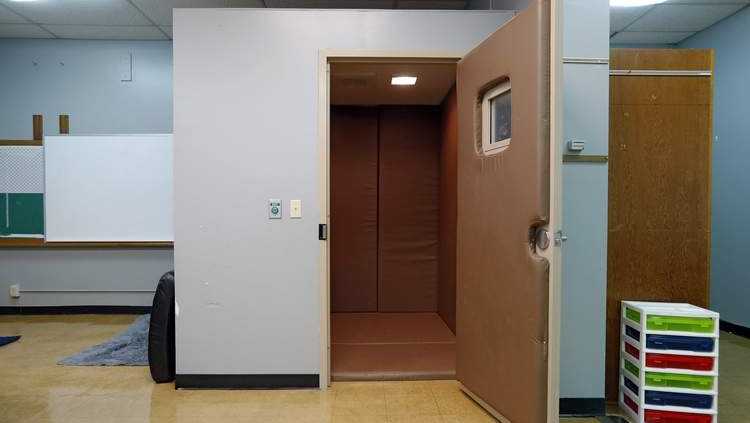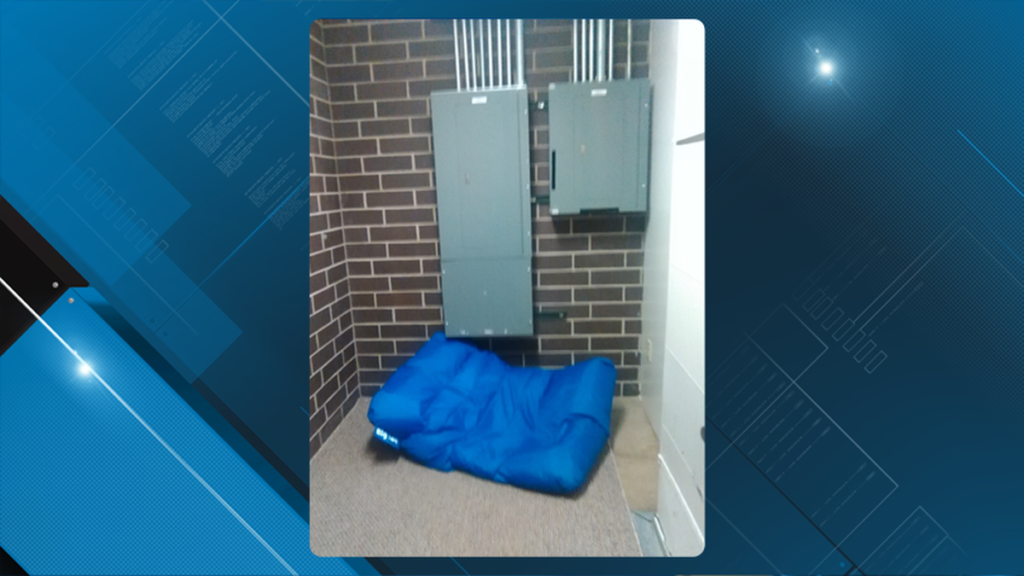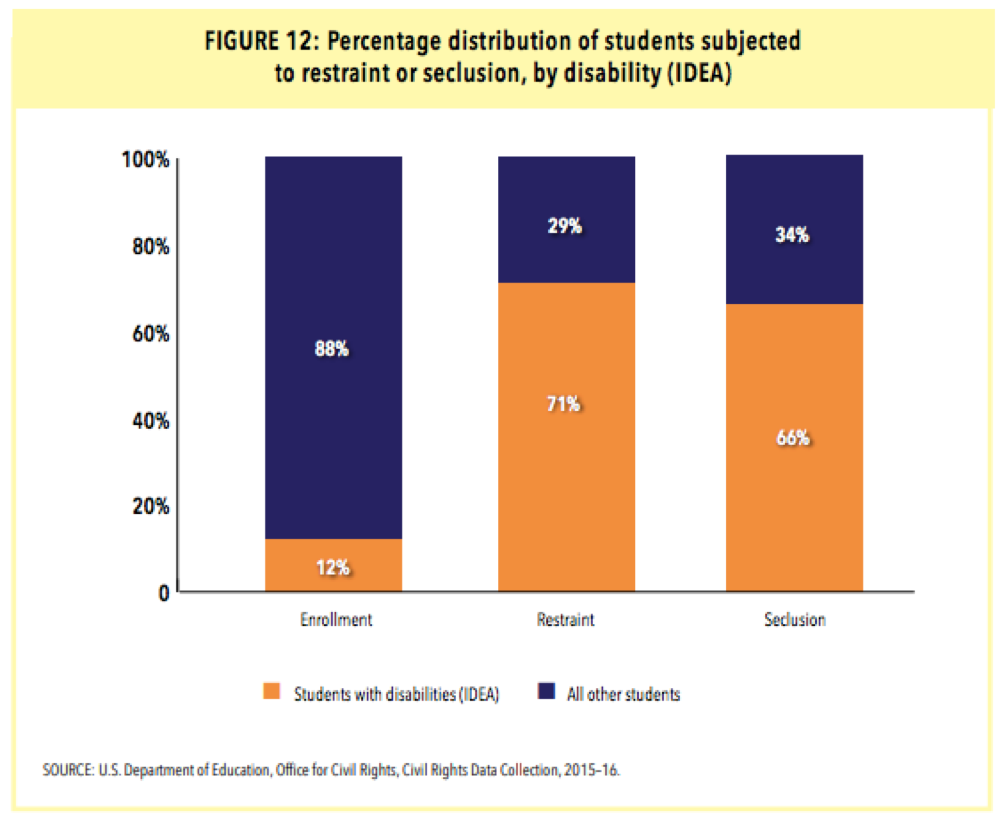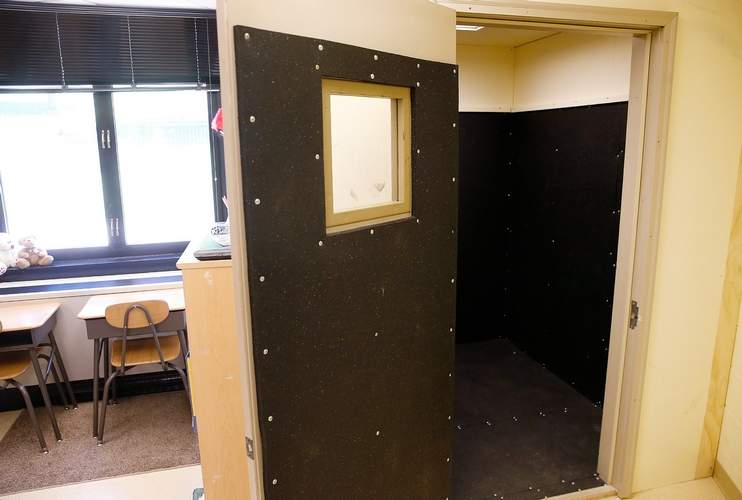
A seclusion room in a Cedar Rapids elementary school: padded walls, a window, a door that locks from outside
Another year ends with stories of children, young children, being thrown into `seclusion rooms’, solitary confinement chambers, in schools across the country. What exactly are children meant to learn, the ones thrown into solitary, the ones watching their classmates and friends go into solitary? What’s the lesson plan, the educational goal? Why are we so invested in seclusion and restraint of children, generally, and of children living with disabilities, particularly? What terrible crime have these children committed that entire systems invest so much in maintaining practices that clearly constitute torture?
In November, U.S. Department of Justice investigators conducted on-site inspections of schools in Cedar Rapids, Iowa. They also demanded thousands of documents. This story begins in 2017, when a parent complained at the abuse her daughter suffered. Apparently, the girl wouldn’t stop crying, and so she was placed in a seclusion room. In the 2019-2020 school year, elementary school children were tossed into seclusion 237 times. In October, 2020, the Department of Justice notified the Cedar Rapids School District that they were opening an investigation.
In 2018, the U.S. Department of Education released a report on school climate and safety for 2015 – 2016. It found that Iowa rates had doubled. For example, in 2013, 23 school districts in eastern Iowa had 2514 reported instances of seclusion or restraint. In 2015, that number rose to 4,904. A 2018 Iowa State report described Davenport as in “systemic non-compliance” of Federal laws concerning the education of students living with disabilities. According to the report, the situation for students of color in Davenport was particularly dire, systemically so. Both of Iowa’s U.S. Senators called for a Federal investigation into the use of seclusion rooms. Davenport’s U.S. Representative Dave Loebsack called for a ban on seclusion rooms.
In 2017, a complaint was filed against the Iowa City school district, charging that the district’s use of seclusion rooms violated Federal law, primarily because parents don’t know that the seclusions rooms existed and were being used and because the use of seclusion rooms is broader and more `ordinary’ than the law allows. During the 2013-14 school year, most of the students dumped into solitary confinement were students with diagnosed disabilities and individualized education plans. Half of the students with education plans who were sent to seclusion rooms were Black. Other than students with education plans, ALL of the students dumped into seclusion rooms in the 2013 – 2014 were Black. Black students comprised about 19% of the school population.
Cedar Rapids is no outlier, not in Iowa, not in the United States. December 31, 2020, the Department of Justice settled with North Gibson School Corporation in Princeton, Indiana, where “students as young as five years old were secluded and restrained improperly and repeatedly, resulting in days, and sometimes weeks, of lost instructional time.”
On October 24, 2021, the U.S. Department of Education and the Saco School District, in Saco, Maine, reached agreement to resolve restraint and seclusion compliance. Saco’s not a big school district, but it boasts big seclusion numbers. From 2017 to 2020, Saco schools engaged in 392 incidents of seclusion. Of that number, 324 involved children in K-2. 83% of those thrown into solitary were children 5 to 7 years old. After extensive investigation and negotiation, they `reached agreement.’
On November 24, 2021, Fairfax County Public Schools, in northern Virginia, reached a settlement with parents of children living with disabilities and advocacy groups to ban all seclusion in all its schools by the beginning of school year 2022 – 2023. This ends a suit that was filed in 2019, after a local news station reported that the county routinely put children with disabilities in seclusion rooms and routinely failed to report the incidents.
A week later, on December 1, the U.S. Department of Justice reached a settlement with the Frederick County Public School District “to address the discriminatory use of seclusion and restraint against students with disabilities …. The investigation, opened in October 2020, revealed thousands of incidents of seclusion and restraint in just two and a half school years. Although students with disabilities make up only 10.8% of students enrolled in the district, every single student the district secluded was a student with disabilities.” When the settlement was reported, many expressed shock, demanded answers, called for responsibility. The county’s school superintendent resigned quickly, and was given $800,000 in compensation. In 2017, that county superintendent was named Superintendent of the Year by the state association of school superintendents.
Every report, every agreement and settlement, evokes shock. How can people be shocked when there are thousands of incidents, as many as ten a day, in small towns and big counties? That the government has returned to some sort of vigilance concerning the systematic abuse and torture of children is welcome, inasmuch as it’s better than inaction. But the real need here is a soul searching, no holds barred transformation. We torture children. We cannot be shocked by that. We send children into days, weeks, of solitary confinement because … they can’t stop crying. And we call that education.

A seclusion room in another Cedar Rapids elementary school
(By Dan Moshenberg)
(Photo Credit 1: KCCI / Liz Martin/The Gazette)) (Photo Credit 2: KCRG / (Josh Scheinblum)


